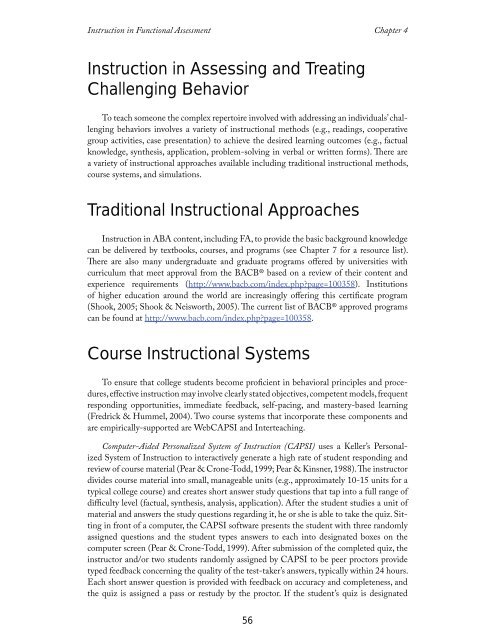Instruction in Functional Assessment, 2014a
Instruction in Functional Assessment, 2014a
Instruction in Functional Assessment, 2014a
Create successful ePaper yourself
Turn your PDF publications into a flip-book with our unique Google optimized e-Paper software.
<strong>Instruction</strong> <strong>in</strong> <strong>Functional</strong> <strong>Assessment</strong> Chapter 4<br />
<strong>Instruction</strong> <strong>in</strong> Assess<strong>in</strong>g and Treat<strong>in</strong>g<br />
Challeng<strong>in</strong>g Behavior<br />
To teach someone the complex repertoire <strong>in</strong>volved with address<strong>in</strong>g an <strong>in</strong>dividuals’ challeng<strong>in</strong>g<br />
behaviors <strong>in</strong>volves a variety of <strong>in</strong>structional methods (e.g., read<strong>in</strong>gs, cooperative<br />
group activities, case presentation) to achieve the desired learn<strong>in</strong>g outcomes (e.g., factual<br />
knowledge, synthesis, application, problem-solv<strong>in</strong>g <strong>in</strong> verbal or written forms). There are<br />
a variety of <strong>in</strong>structional approaches available <strong>in</strong>clud<strong>in</strong>g traditional <strong>in</strong>structional methods,<br />
course systems, and simulations.<br />
Traditional <strong>Instruction</strong>al Approaches<br />
<strong>Instruction</strong> <strong>in</strong> ABA content, <strong>in</strong>clud<strong>in</strong>g FA, to provide the basic background knowledge<br />
can be delivered by textbooks, courses, and programs (see Chapter 7 for a resource list).<br />
There are also many undergraduate and graduate programs offered by universities with<br />
curriculum that meet approval from the BACB® based on a review of their content and<br />
experience requirements (http://www.bacb.com/<strong>in</strong>dex.php?page=100358). Institutions<br />
of higher education around the world are <strong>in</strong>creas<strong>in</strong>gly offer<strong>in</strong>g this certificate program<br />
(Shook, 2005; Shook & Neisworth, 2005). The current list of BACB® approved programs<br />
can be found at http://www.bacb.com/<strong>in</strong>dex.php?page=100358.<br />
Course <strong>Instruction</strong>al Systems<br />
To ensure that college students become proficient <strong>in</strong> behavioral pr<strong>in</strong>ciples and procedures,<br />
effective <strong>in</strong>struction may <strong>in</strong>volve clearly stated objectives, competent models, frequent<br />
respond<strong>in</strong>g opportunities, immediate feedback, self-pac<strong>in</strong>g, and mastery-based learn<strong>in</strong>g<br />
(Fredrick & Hummel, 2004). Two course systems that <strong>in</strong>corporate these components and<br />
are empirically-supported are WebCAPSI and Interteach<strong>in</strong>g.<br />
Computer-Aided Personalized System of <strong>Instruction</strong> (CAPSI) uses a Keller’s Personalized<br />
System of <strong>Instruction</strong> to <strong>in</strong>teractively generate a high rate of student respond<strong>in</strong>g and<br />
review of course material (Pear & Crone-Todd, 1999; Pear & K<strong>in</strong>sner, 1988). The <strong>in</strong>structor<br />
divides course material <strong>in</strong>to small, manageable units (e.g., approximately 10-15 units for a<br />
typical college course) and creates short answer study questions that tap <strong>in</strong>to a full range of<br />
difficulty level (factual, synthesis, analysis, application). After the student studies a unit of<br />
material and answers the study questions regard<strong>in</strong>g it, he or she is able to take the quiz. Sitt<strong>in</strong>g<br />
<strong>in</strong> front of a computer, the CAPSI software presents the student with three randomly<br />
assigned questions and the student types answers to each <strong>in</strong>to designated boxes on the<br />
computer screen (Pear & Crone-Todd, 1999). After submission of the completed quiz, the<br />
<strong>in</strong>structor and/or two students randomly assigned by CAPSI to be peer proctors provide<br />
typed feedback concern<strong>in</strong>g the quality of the test-taker’s answers, typically with<strong>in</strong> 24 hours.<br />
Each short answer question is provided with feedback on accuracy and completeness, and<br />
the quiz is assigned a pass or restudy by the proctor. If the student’s quiz is designated<br />
56


















